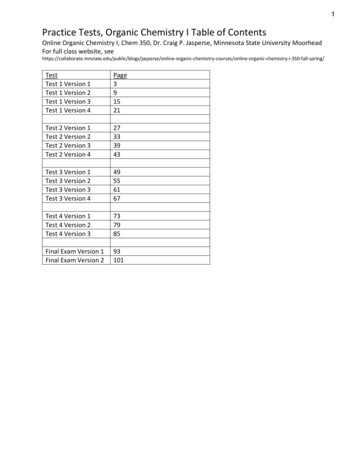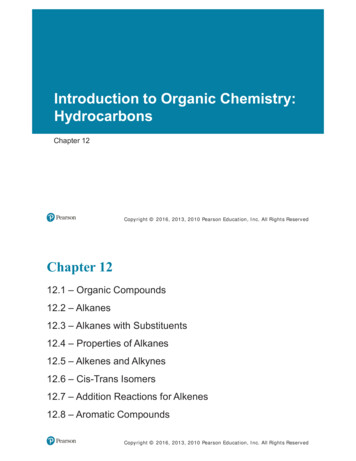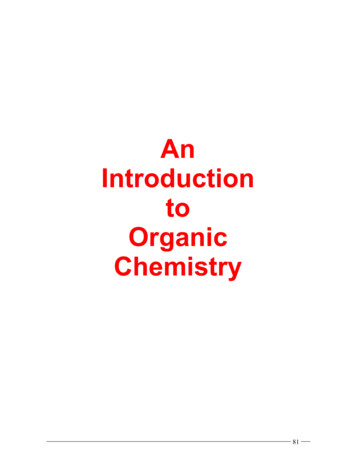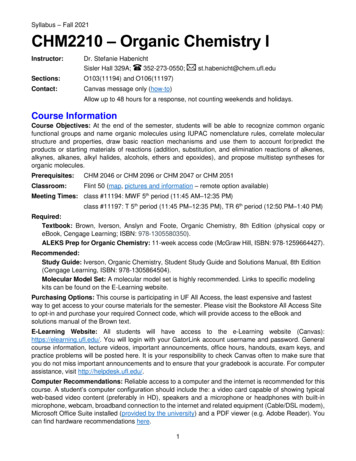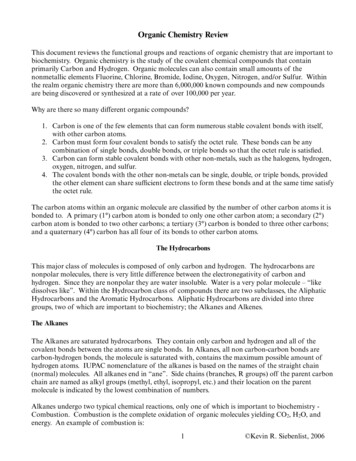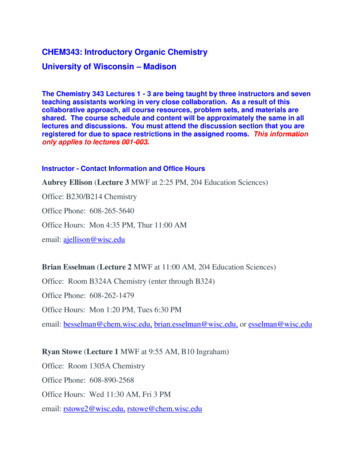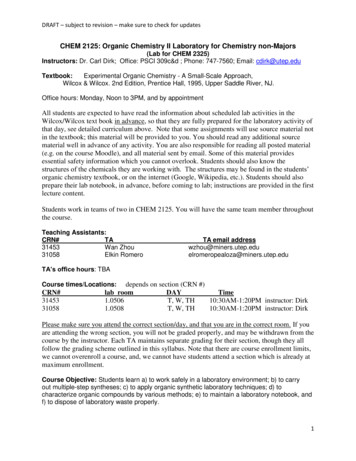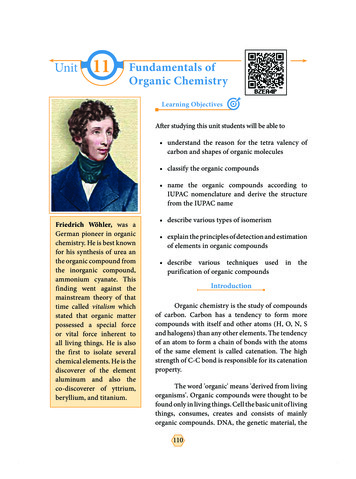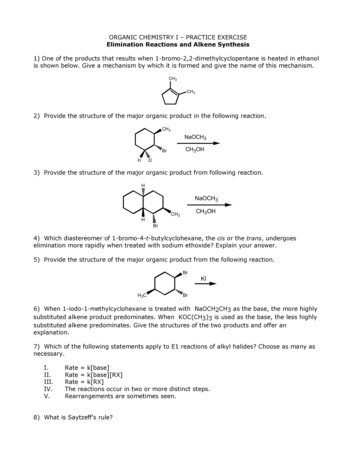
Transcription
ORGANIC CHEMISTRY I – PRACTICE EXERCISEElimination Reactions and Alkene Synthesis1) One of the products that results when 1-bromo-2,2-dimethylcyclopentane is heated in ethanolis shown below. Give a mechanism by which it is formed and give the name of this mechanism.CH3CH32) Provide the structure of the major organic product in the following reaction.CH3NaOCH3CH3OHBrHD3) Provide the structure of the major organic product from following reaction.HNaOCH3CH3OHCH3HBr4) Which diastereomer of 1-bromo-4-t-butylcyclohexane, the cis or the trans, undergoeselimination more rapidly when treated with sodium ethoxide? Explain your answer.5) Provide the structure of the major organic product from the following reaction.BrKIH3CBr6) When 1-iodo-1-methylcyclohexane is treated with NaOCH2CH3 as the base, the more highlysubstituted alkene product predominates. When KOC(CH3)3 is used as the base, the less highlysubstituted alkene predominates. Give the structures of the two products and offer anexplanation.7) Which of the following statements apply to E1 reactions of alkyl halides? Choose as many asnecessary.I.II.III.IV.V.Rate k[base]Rate k[base][RX]Rate k[RX]The reactions occur in two or more distinct steps.Rearrangements are sometimes seen.8) What is Saytzeff's rule?
9) What major product results when 2-bromo-2-methylbutane is treated with sodium ethoxide.10) How many distinct alkenes can result from E2 elimination of the compound below? Give theirstructures and IUPAC names.ICH311) Give the major product and the mechanism of the following reaction.H3CHPhPhNaOCH3CH3OHBr12) Predict the most likely mechanism and the product for the reaction below.NaOCH3CH3OHH3CH3CCl13) Predict the most likely mechanism and the product from the reaction between2-chloro-2-methylpentane and sodium ethoxide in ethanol.14) The major product which results when 2-chloro-2-methylpentane is heated in ethanol is anether. Show and name the mechanism by which this ether forms.15) Which of the following mechanisms feature carbocation intermediates?A) SN1 onlyB) SN2 onlyC) E1 onlyD) E2 onlyE) both SN1 and E116) Which mechanism(s) give(s) alkenes as the major products, Sn1, Sn2, E1, or E2?17) Which compound produces only one alkene when treated with sodium methoxide?A) 2-chloro-2-methylpentaneB) 3-chloro-3-ethylpentaneC) 3-chloro-2-methylpentaneD) 2-chloro-4-methylpentaneE) 2-chloro-3-ethylpentane18) When 3-iodo-3-ethylpentane is treated with sodium methoxide in methanol, the majororganic product is an that is generated through an mechanism.A) ether, SN1B) ether, SN2C) ether, E1D) alkene, E2E) alkene, E1
19) Provide the structure of the major alkene product of the reaction below.H3CCH3BrNaOH20) Based on Saytzeff's rule, select the most stable alkene.A) 1-methylcyclohexeneB) 3-methylcyclohexeneC) 4-methylcyclohexeneD) They are all of equal stability21) Based on Saytzeff's rule, select the most stable alkene.A) 1,2-dimethylcyclohexeneB) 1,6-dimethylcyclohexeneC) cis-3,4-dimethylcyclohexeneD) They are all of equal stabilityFOR QS. 22-24, DRAW ALL ALKENE PRODUCTS AND CIRCLE THE PREDOMINANT ONE.22)BrCH3NaOHacetone23)BrCH3- (CH3)3CO K(CH3)3COH24)BrBrZnCH3COOH25) Propose a detailed, step-by-step mechanism for the reaction shown below.CH3CH3OHCH3H2SO4DCH326) Draw all likely products of the following reaction and circle the product you expect topredominate.OHH2SO4D
27) Draw all likely products of the following reaction and circle the product you expect topredominate.CH3H2SO4OHD28) Which base, ammonia (NH3) or triethylamine [(CH3CH2)3N], would be more effective to usefor the following conversion?BaseCl29) Which compound would undergoe dehydrohalogenation with strong base to give the alkeneshown below as the only alkene product?CH3 CH2A) 1-chloropentaneB) 2-chloropentaneC) 3-chloropentaneD) 1-chloro-2-methylbutaneE) 1-chloro-3-methylbutaneCHCHCH3FOR SYNTHESES # 30-32 GIVE THE MISSING REAGENTS AND STRUCTURES.30)ABC31)ABC32)ABC33) Which of the following statements applies to the E2 mechanism?A) It occurs with inversion of stereochemistry.B) It occurs with racemization of stereochemistry.C) It proceeds through the more stable carbocation intermediate.D) The C-H and C-X bonds that break must be anti.E) Use of a bulky base gives the more highly substituted alkene product.
ANSWERS1)E1 mechanism with carbocation rearrangementBrCH31)CH3ethanolCH3 CH3CH3 H2OCH2CH32) In questions 2 and 3, only the proton trans to the leaving group can eliminate.CH3D3)HCH34) Due to the presence of the bulky t-butyl group, the ring is practically locked up in the moststable conformation with the bulky group being equatorial.HBrBrHt-But-BuHcisHtranst-Bu t-Butyl groupOf the two isomers, the cis is the only one that fulfills the anticoplanar arrangement for E2, wherethe leaving group and adjacent proton must be anti to each other and in the same plane.
HBrBrHHHt-But-BuHHHHcistransThe atoms shown in red cannot fulfillthe anticoplanar requirement.Elimination is slower or not possibleThe atoms shown in red fulfill theanticoplanar requirement for E2.Elimination is possible and fast.5)H3C6) The small, unhindered base ethoxide yields the more stable alkene (Saytzeff’s product, i.e.the more highly substituted alkene). When the bulky t-butoxide base is used, the most accessiblehydrogen is removed. This results in the least highly substituted alkene (Hoffman’s product).CH3ICH3CH3CH2OSaytzeff's productCH3H3COCH3CH2Hoffman's product7) III, IV, and V.8) In elimination reactions, the most highly substituted alkene predominates.9)HCH3H3CCH3
67211(Z)-3-methyloct-3-ene2-Ethylheptene11) E2. The molecule must rotate around the central cabon-carbon bond to aquire theanticoplanar arrangement required for E2. This is a stereospecific reaction that results information of the product where the phenyl groups are cis to each other.H3CHPhPh12) Strong base and bulky substrate favor E2. Only carbon 6 has protons trans to the leavinggroup. The pi bond can only form between carbons 1 and 6. Can you name the product by IUPACrules?32H3C41H3C5NaOCH36HHCH3OHH3CH3CCl13) Strong base and bulky substrate favor E2 with preferential formation of Saytzeff’s product.NaOCH2CH3ClCH3CH2OH
14) Weak nucleophile (ethanol, the solvent) and bulky substrate favor Sn1 as shown below. Canyou tell which is the rate-determining step? Can you tell what type of reaction is involved in thelast step?CH3CH2OH1) ClDCl 2)HOCH2CH3OH3) HOCH2CH3OOHether15) E16) E1 and E217) B18) D19) The reacton is E2. See question 12 for a similar case.H3CCH3H3CBr20) A21) A22)CH3CH2 23)CH3CH2 NaOHCH3CH3CH2OH2
24)25) First step is protonation of the alcohol by the strong acid to form a potential water moleculeas a leaving group. Next is departure of the leaving group with formation of a carbocation. Next isa carbocation rearrangement from secondary to tertiary. The last step is an elimination stepwhere the water abstracts the acidic proton next to the positive charge to form the alkene.O 1)HOHOS OHO2)HSO4OH2 H2OOH23)HSO44)Hor H2O H3Oor H2SO426)27)28) Triethylamine. Amines can be nucleophiles or bases. Increasing their steric bulk near thenitrogen atom diminishes their nucleophilicity while retaining the basicity. Since the substrate issterically accessible to nucleophilic attack, a bulky base is needed to promote elimination.
29) C30) This is a typical example of a simple, multistep synthesis (in this case only two steps). Thistests your ability to use previously learned reactions (e.g. from ch. 4) to design a synthesistowards a particular product, in this case cyclopentene. The last step is an elimination reaction.Any strong base combination will serve the same purpose as NaOH and acetone.BrBr2NaOHhvacetoneABC31) Similar to the previous problem, but this time Hoffman’s product is desired. A bulky basemust be used in the last step, such as t-butoxide ion.-Br2t-BuOhnABrt-BuOHCBHoffman'sproduct32) Same as above, but this time Sayteff’s product is desired. A small base must be used in thelast step.Br2NaOHhnA33) DBrBacetoneCSaytzeff'sproduct
ORGANIC CHEMISTRY I – PRACTICE EXERCISE Elimination Reactions and Alkene Synthesis 1) One of the products that results when 1-bromo-2,2-dimethylcyclopentane is heated in ethanol is shown below. Give

